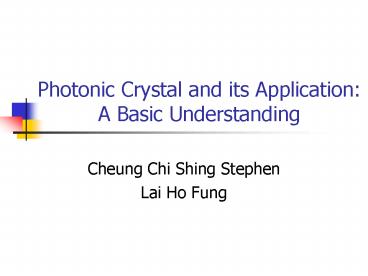Photonic Crystal and its Application: A Basic Understanding - PowerPoint PPT Presentation
1 / 44
Title:
Photonic Crystal and its Application: A Basic Understanding
Description:
1887: Lord Rayleigh's study of Bragg Diffraction of 1-D PC ... eGaAs: 13, eGaAlAs:12, eAir:~1. ?e, range of photonic bandgap. Photonic Crystals: Definition ... – PowerPoint PPT presentation
Number of Views:190
Avg rating:3.0/5.0
Title: Photonic Crystal and its Application: A Basic Understanding
1
Photonic Crystal and its Application A Basic
Understanding
- Cheung Chi Shing Stephen
- Lai Ho Fung
2
Photonic Crystal Some History
- 1887 Lord Rayleighs study of Bragg Diffraction
of 1-D PC - - propose of 1-D photonic bandgap(stop band)
3
Photonic Crystal Some History
- At 1987(100 years later!!!)
- -Eli Yablonovitch
- control of spontaneous emission of materials
in PC - -Sajeev John
- defected high-D PC give rise to strong
localization of light
4
Some daily examples - Butterflies
5
Some daily examples shells
6
Some daily examples
- A scan by SEM of the butterfly wing (blue)
7
Photonic Crystals Definition
- Periodic structures with alternating refractive
index (dielectric constant)
8
Photonic Crystals Definition
- 1-D multi-layer membrane
- 2-D air columns in dielectric material
- 3-D stacking structure
9
Photonic Crystals Definition
- Crucial property
- Photonic bandgap-
- Range of lights frequencies which the light
cannot pass throught PCWHY? - because
- BRAGG DIFFRACTION!
10
Photonic Crystals Definition
Constructive interference 2d sin? n?. ( O(d)
O(?) )
11
Photonic Crystals Definition
- eGaAs 13, eGaAlAs12, eAir1
- ??e?, range of photonic bandgap ?
12
Computational method
- So, how do we know the PBG of a certain PC?
- EM waves travelling in PC are described by
Maxwell Eqs.
13
Computational method
- 1. Plane-wave expansion method
- Assume plane wave solutions, i.e.,
14
Computational method
- The two curl equation can be rewritten as
15
Computational method
- Where the first one is just like a
- Schrödinger equation with
- being the operator
- (?(k)/c)2 being the corresponding
eigenvalue
16
Computational method
- Hence given the boundary conditioins, i.e., the
structure of the PC and e(r), H(r) and E(r) can
be found - Hk(r) ei(k.r) uk(r)
17
Computational method
- An analogy to electronic bandgap in semiconductor
18
Computational method
- 2. FDTD (Finite-difference time domain) method
- Consider again the two curl equations
19
Computational method
- They can be expanded into
20
Computational method
An electromagnetic wave interaction structure is
mapped into the space lattice by assigning
appropriate values of permittivity to each
electric field component, and permeability to
each magnetic field component.
21
Physical Phenomena
- 1. Photonic bandgap(PBG)
- Bragg diffraction -gt destructive interference in
PC -gt Photonic badgap - 1-D PC only in one direction
- Because periodicity becomes different if the
wave enters in a different direction
22
Physical Phenomena
- 2-D PC 2-D PBG
- 3-D PC possibility of PBG in all direction
23
Physical Phenomena
- 2. Strong localization of light
- If defects are introduced to the PC, light can
be trapped within the defect.
24
Physical Phenomena
- 3. wave guide
25
Physical Phenomena
- 4. light spliter
26
Applications
- Photonic crystal fiber ( PCF )
- Laser
- Future development
27
Photonic crystal fiber ( PCF )
- Benefits
- high transmission speed
- not much interaction between photons
- ? low energy loss
28
Photonic crystal fiber ( PCF )
- Air guiding PCF
29
Photonic crystal fiber ( PCF )
- 1800 C
- 0.03mm
30
(No Transcript)
31
Photonic crystal fiber ( PCF )
- Range of wavelength 440nm 2000nm
- Best reported loss
- 13dB/km over 100m _at_1.5µm
- wavelength
32
Photonic crystal fiber ( PCF )
- Holey-assisted fiber
- Holey cladding
- (low refractive index)
- Core (high refractive
index)
33
Photonic crystal fiber ( PCF )
- As the refractive index of the central defect
core is relative higher than the holey cladding
materials - ? wave is rather confined and transmits in the
core
34
Photonic crystal fiber ( PCF )
- Group dispersion is reduced to minimium
- Core area is 10 times greater than that of optic
fiber - Single mode maintains within a large range of
wavelength
35
Laser
- Pumping / Exciting
- Population inversion
- Spontaneous
Stimulated - emission
emission - Energy loss
Resonator
36
Laser
- Probability of an atom in excited state is given
by
37
Laser
- One may think increasing the temperature can
increase the population of excited atoms - ? Blackbody radiation
38
Laser
39
Laser
- However, blackbody radiation cannot produce
intensive and monochromatic radiation - One may try to reduce energy loss by using
Photonic crystal as the resonator shielder
40
Laser
- Relation between photonic band gap and
semiconductor laser
41
Laser
42
Laser
- Spontaneous emission of excited electrons are
inhibited - Probability of electrons maintaining in the
excited states ? - Population inversion of laser ?
- Simulated emission ?
- Power loss ?
43
Future development
- Size in micro- order devices
- Largely reduce the size of communication system
to 1000 times
44
Photonic crystal and its applications
- Q A































